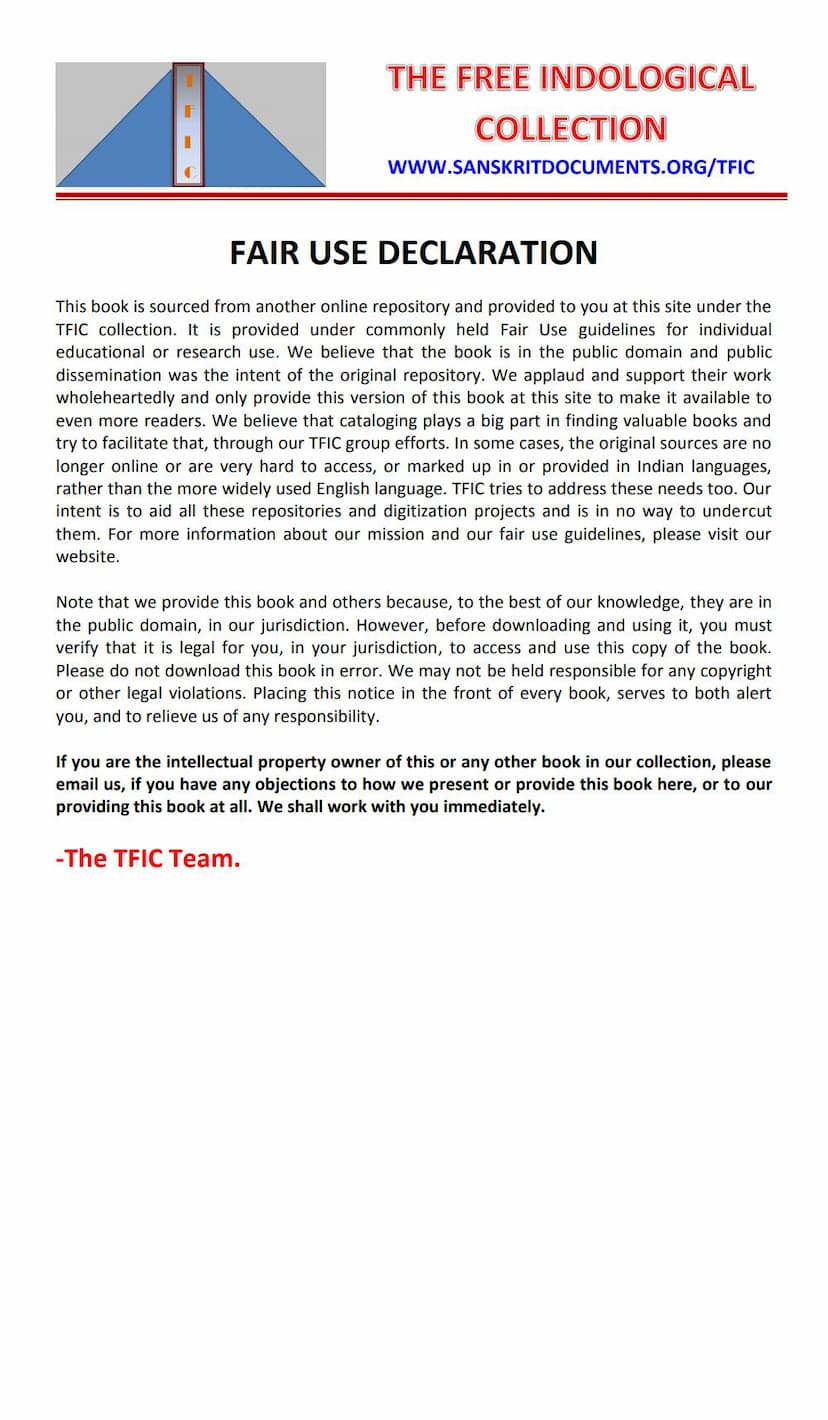Samyaktva Suryodaya Jain Arthat Mithyatva Timir Nashak
Added to library: September 2, 2025

Summary
This is a comprehensive summary of the Jain text "Samyaktva Suryodaya Jain arthath Mithyatva Timir Nashak" by Parvati Sati, published by Kruparam Kotumal. The book aims to dispel misconceptions about Jainism and clarify its core tenets, particularly concerning God and the nature of reality, contrasting it with other philosophical viewpoints.
Key Themes and Arguments:
The book primarily engages in a question-and-answer format, addressing various theological and philosophical points of contention, often through dialogues with "Arias" (likely referring to followers of Vedic traditions, particularly Dayanand Saraswati's Arya Samaj). The central argument revolves around refuting the concept of an anthropomorphic, creator God (Ishvara) as understood in other religions and establishing the Jain understanding of the universe and liberation.
Core Jain Principles Presented:
-
Nature of God (Ishvara):
- Jains acknowledge a Supreme Being, but define it as a state of perfect liberation (Siddha/Mukta Atma) – an omniscient, omnipotent, blissful, and eternal soul, devoid of any form, attributes, or worldly activities. This is contrasted with the concept of a creator God.
- The book emphasizes that the qualities described for a liberated soul in Jain scriptures are attributed to this ultimate spiritual state, not a separate, active creator deity.
- The author argues against the notion of God as a creator of the universe, asserting that the universe, comprising souls (Jiva) and matter (Pudgala), is eternal and without beginning.
- The "creator God" concept is seen as leading to several logical fallacies, including powerlessness, ignorance, injustice, and lack of compassion, which are elaborated with examples and arguments.
-
Karma and Rebirth:
- Jainism posits that all experiences of happiness and suffering are due to karma. The soul, through its actions, creates karmic matter that binds it.
- Karma is described as the primary agent of cause and effect, rather than an external deity.
- The book clarifies the Jain view on how karma travels and produces results, even after the physical body perishes, often using analogies like wine in a bottle affecting the drinker.
- It asserts that both the soul and karma are eternal, addressing the question of how liberation is possible from an eternal cycle.
-
The Soul (Jiva) and Matter (Pudgala):
- The fundamental Jain ontological framework of two eternal substances – Jiva (soul/consciousness) and Ajiva (non-soul, including matter) – is presented.
- The book details the nature of soul and matter, including their attributes and transformations, explaining concepts like atoms (Anu) and their aggregation into larger forms (Pudgala).
- The Jain understanding of the universe's composition and its dynamic nature, driven by the interaction of these fundamental substances and their inherent qualities, is discussed.
-
Liberation (Moksha/Nirvana):
- Moksha is described as the state of being free from the bondage of karma, leading to the soul's inherent qualities of omniscience, infinite bliss, and pure consciousness being fully manifest.
- It is not seen as a return to a creator but as the soul realizing its true, unadulterated nature.
- The text distinguishes between different types of "relationship" between substances (e.g., inherence, cause-effect, conjunction) to explain how liberation is achieved.
-
Critique of Other Religious Views (Primarily Vedic/Arya Samaj):
- A significant portion of the book is dedicated to refuting the Vedic concept of a creator God. It challenges arguments presented by figures like Dayanand Saraswati.
- The book scrutinizes scriptural interpretations, pointing out perceived contradictions and illogical assertions in Vedic texts regarding God's creation, intervention, and attributes.
- It addresses claims that Jainism promotes violence or unethical practices, clarifying the Jain emphasis on non-violence (Ahimsa) and ethical conduct.
- Misinterpretations of Jain scriptures, such as the use of terms like "Mansa" (meat) or "Mahu" (honey) referring to fruits or medicinal substances, are corrected.
- The book debunks claims that Jain texts are contradictory or contain fabricated narratives, asserting the authenticity and depth of Jain philosophy.
-
The Meaning of "Aarya":
- The text clarifies that the term "Aarya" in Jain tradition refers to followers of Jainism, whose name originated from the ancient land of Aryavarta and was further popularized by Rishabhadeva and Emperor Bharata. It distinguishes this from the later usage of "Arya Samaj."
-
The Nature of Truth and Scripture:
- The book advocates for a critical and discerning approach to all religious texts, emphasizing that the true path is one that aligns with reason, logic, and ethical principles.
- It highlights the importance of understanding the context and intended meaning of scriptural passages, often through analogy and logical reasoning.
Structure and Style:
The book is structured as a dialogue, making complex philosophical ideas accessible through direct questions and answers. It uses analogies, examples, and citations (though the specific references are not fully detailed here) to support its arguments. The author, Parvati Sati, presents herself as a knowledgeable Jain scholar and preacher.
Overall Purpose:
"Samyaktva Suryodaya Jain" is a defense of Jain philosophy and a critique of opposing views, particularly those that attribute creation and divine intervention to an external God. It seeks to guide readers towards a correct understanding of Jainism, emphasizing self-reliance, karma, and the soul's potential for liberation through righteous conduct and knowledge, thereby dispelling the "darkness of false beliefs" (Mithyatva Timir Nashak).